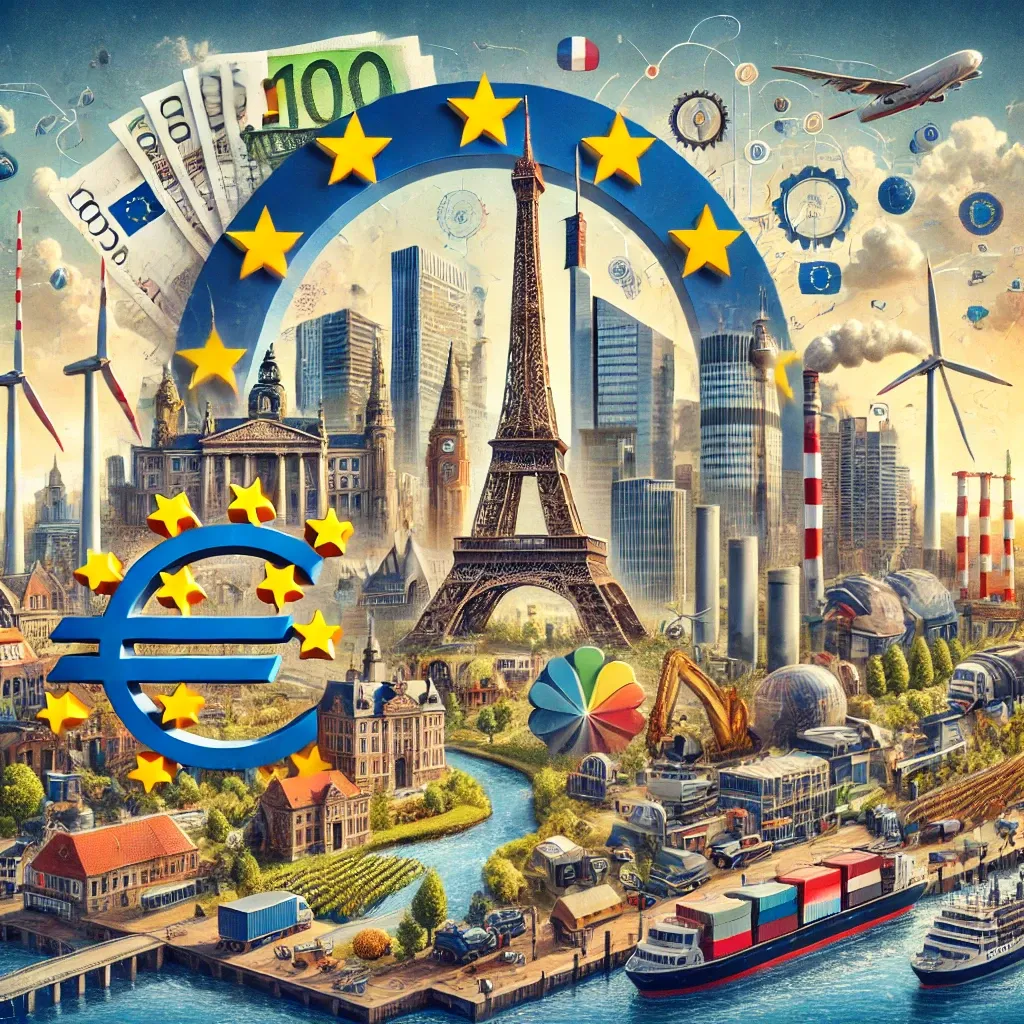Economic Report EU
The European Union, the world's second-largest economy, has historically been a hub of innovation, industry, and global influence. However, economic stagnation, demographic shifts, and energy challenges have placed the EU at a crossroads.

Introduction
The European Union, the world's second-largest economy, has historically been a hub of innovation, industry, and global influence. However, economic stagnation, demographic shifts, and energy challenges have placed the EU at a crossroads. This report analyzes key factors affecting the EU’s economic and social landscape, focusing on labour dynamics, migration, energy, and innovation.
Key Findings
1. Economic Performance
- The EU is the second-largest global economy, with Germany leading as the bloc's economic powerhouse.
- Economic growth has slowed, with nearly two decades of relative stagnation compared to the USA and emerging economies.
- The EU's GDP per capita remains high, but regional disparities persist, particularly between northern and southern member states.
2. Labour Force and Demographics
- Labour force participation in the EU has increased but includes a significant proportion of older workers staying employed out of necessity.
- Birth rates across all member states are below replacement levels, leading to an aging population and workforce shortages.
- Unemployment rates, while declining, remain higher than in comparable economies like the USA.
3. Migration Dynamics
- Immigration sustains population growth but is often tied to social policies (e.g., family reunification, asylum) rather than economic needs.
- High-skilled migration into the EU is limited compared to other advanced economies, such as the USA and Canada.
- Brain drain is a significant issue, with young, highly educated workers emigrating for better opportunities, particularly in tech and finance sectors.
4. Energy and Infrastructure
- The EU is heavily reliant on energy imports, particularly natural gas and oil, with limited domestic reserves.
- Renewables investment is substantial but not yet sufficient to offset the loss of fossil fuel imports, particularly from Russia.
- Infrastructure, while advanced, faces challenges in modernization and integration across member states.
5. Innovation and Technology
- The EU lags behind the USA and China in technological innovation and adoption, particularly in high-tech and software industries.
- Strict regulations and fragmented markets hinder startups and new technologies from scaling effectively within the bloc.
- Despite a strong engineering base, the EU struggles to attract and retain talent in cutting-edge fields like AI, semiconductors, and biotechnology.
6. Social and Economic Disparities
- Quality of life indicators like healthcare, education, and living standards remain strong but vary significantly across regions.
- Southern and eastern member states face higher unemployment and lower productivity compared to northern and western Europe.
- The cost of living, particularly housing, is rising in urban centers, exacerbating inequality.
Key Areas of Focus
1. Labour Dynamics
- An aging workforce and low birth rates threaten long-term economic stability.
- Policies to integrate older workers and improve youth employment are underdeveloped.
2. Migration Policy
- Socially motivated migration policies do not adequately address labour market needs.
- A unified EU-wide approach to high-skilled immigration could enhance competitiveness.
3. Energy Transition
- Reliance on external energy sources creates vulnerability to geopolitical shifts.
- Renewable energy investments are promising but require faster deployment and grid modernization.
4. Innovation Ecosystem
- EU regulations, while protecting consumers, often hinder innovation and competitiveness.
- A fragmented market limits the scalability of startups compared to the USA and China.
5. Social Equity
- Regional disparities within the EU threaten cohesion and economic parity.
- Expanding funding and opportunities for less developed member states is essential for balance.
Opportunities for Improvement
Labour Force
- Policy Action: Promote reskilling programs and cross-border labour mobility within the EU.
- Private Sector Role: Develop training partnerships with universities to address skill gaps.
Migration
- Policy Action: Streamline processes for high-skilled visas and attract talent from non-EU countries.
- Private Sector Role: Offer incentives and job placements to high-skilled immigrants in underserved sectors.
Energy Transition
- Policy Action: Increase funding for renewable energy projects and energy storage solutions.
- Private Sector Role: Accelerate investment in green technology and energy-efficient manufacturing.
Innovation
- Policy Action: Simplify regulatory frameworks to encourage tech startups and innovation.
- Private Sector Role: Establish venture capital funds and R&D centers to foster technological advancement.
Social Equity
- Policy Action: Increase EU structural funds for underdeveloped regions to bridge disparities.
- Private Sector Role: Invest in regional development projects and local supply chains.
Comparative Insights
- Unlike the USA, the EU's fragmented regulatory environment and diverse languages create barriers to scaling innovation and industry.
- Compared to China, the EU’s reliance on external energy sources limits its economic resilience, while strict regulations hinder rapid industrial transformation.
- The EU's focus on quality of life provides a strong social foundation but risks stagnation without addressing economic imbalances and competitiveness.
Conclusion
The EU's economic strengths, including its high living standards and advanced industrial base, are counterbalanced by stagnation, an aging workforce, and innovation gaps. Addressing these challenges will require coordinated efforts across member states to harmonize policies, invest in future technologies, and bridge regional disparities. By focusing on labour, energy, innovation, and equity, the EU can position itself for sustainable growth in a competitive global economy.
